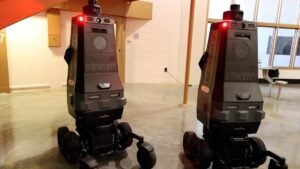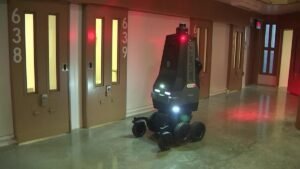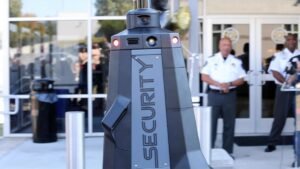Georgia Correctional Facility Enhances Security with Sentry Robots
In a notable advancement for modern corrections, the Cobb County Sheriff’s Office has introduced a pioneering pilot program featuring advanced robotic technology at its adult correctional facility. This initiative involves the deployment of DEKA’s Sentry Robots, a cutting-edge solution designed to improve security measures and streamline operations within the facility. By leveraging this innovative technology, the Sheriff’s Office aims to enhance safety, efficiency, and overall management of the correctional environment.(Toogoodonline)

The Evolution of Technology in Corrections
In recent years, the correctional landscape has evolved significantly, driven by the need for improved safety protocols and operational efficiencies. Traditional methods of surveillance and monitoring are increasingly supplemented—or even replaced—by technological advancements. As correctional facilities grapple with various challenges, the integration of technology offers a promising pathway to enhance security and reduce risks.
The incorporation of robotic systems into correctional environments represents a transformative shift. Sentry Robots are not only designed to monitor but also to provide actionable insights that can help staff manage situations proactively. Their deployment is indicative of a broader trend in law enforcement to embrace innovative tools that can improve outcomes in complex settings.
Introducing DEKA’s Sentry Robots
DEKA’s Sentry Robots are equipped with an array of advanced features tailored for security applications in correctional facilities. These robotic sentinels are designed with high-definition cameras, sophisticated sensors, and real-time data processing capabilities. This combination allows the Sentry Robots to autonomously navigate through various areas of the facility, conducting surveillance and monitoring activities without human intervention.
One of the standout features of the Sentry Robots is their ability to provide continuous, 24/7 surveillance. Unlike human staff, who require breaks and can become fatigued, these robots operate tirelessly, ensuring that every corner of the facility is under constant observation. Their mobility allows them to patrol common areas, corridors, and even isolated sections, enhancing the overall security posture of the facility.
Benefits of Implementing Sentry Robots
The introduction of Sentry Robots at the Cobb County correctional facility is expected to yield multiple benefits, including:
- Enhanced Surveillance Capabilities: The Sentry Robots’ advanced camera systems enable high-resolution monitoring of activities throughout the facility. This comprehensive coverage helps identify potential security threats or disturbances, allowing for prompt intervention.
- Increased Safety for Staff and Inmates: By utilizing robotic technology for routine monitoring, correctional officers can focus on more critical aspects of their roles, such as managing inmate behavior and responding to incidents. This shift can lead to a safer environment where officers can proactively address conflicts before they escalate.
- Rapid Response to Incidents: In the event of a disturbance or emergency, Sentry Robots can relay real-time data to staff, facilitating quick decision-making and response. The ability to provide immediate situational awareness enhances the facility’s capacity to manage incidents effectively.
- Cost-Effectiveness: While the initial cost of implementing robotic systems may be substantial, the long-term savings can be significant. By reducing the need for extensive human monitoring in certain areas, the facility can allocate resources more efficiently, ultimately lowering operational costs.
- Data Collection and Analytics: Sentry Robots are capable of collecting and analyzing data over time, providing valuable insights into inmate behavior and facility operations. This data can inform future strategies for inmate management, rehabilitation, and security improvements.

Addressing Challenges and Concerns
Despite the numerous advantages, the introduction of Sentry Robots is not without its challenges. The Cobb County Sheriff’s Office must navigate several considerations to ensure a successful implementation:
- Integration with Existing Systems: Successfully incorporating robotic technology requires careful planning to ensure it meshes seamlessly with current security protocols and procedures. This includes training staff on how to operate and interact with the robots effectively.
- Privacy and Ethical Considerations: The use of surveillance technology raises important questions about privacy and the ethical implications of monitoring inmates. It is crucial for the Sheriff’s Office to establish clear policies regarding data usage, storage, and retention to address these concerns adequately.
- Technological Reliability and Maintenance: While robotic technology can enhance security, it is essential to recognize that it is not foolproof. Continuous monitoring and maintenance of the robots are necessary to ensure their reliability and effectiveness. Contingency plans should be in place to address any technical failures promptly.
- Maintaining Human Interaction: The role of correctional officers extends beyond surveillance; they also engage in rehabilitative efforts and manage inmate interactions. Striking a balance between technology and human presence is vital to fostering a positive environment within the facility.
The Pilot Program and Its Implementation
The pilot program for Sentry Robots at the Cobb County correctional facility is designed to assess the feasibility and effectiveness of this technology in a real-world setting. The program will involve deploying several Sentry Robots across various areas of the facility, allowing the Sheriff’s Office to gather data and feedback from staff and inmates.
During the initial phase of the program, the focus will be on monitoring the robots’ performance in terms of surveillance capabilities, incident response, and overall impact on facility operations. Staff will be trained to interact with the robots, utilizing their data to enhance decision-making processes and improve security protocols.
Feedback from correctional officers and administrative staff will be critical in evaluating the program’s success. Their insights will help identify potential areas for improvement and inform future deployments of robotic technology within the facility.(Toogoodonline)
Evaluating Impact on Facility Culture
As the pilot program progresses, it will be essential to assess not only the operational benefits of Sentry Robots but also their impact on the culture within the correctional facility. The integration of technology can alter the dynamics of inmate-staff interactions, and understanding these changes will be crucial for maintaining a positive environment.
Regular assessments and surveys may be conducted to gauge staff and inmate perceptions of the robots’ presence. This feedback will provide valuable insights into how the technology is received and its implications for relationships within the facility.

Future Considerations and Broader Applications
The success of the pilot program in Cobb County could set a precedent for broader adoption of robotic technology in correctional facilities across the state and nation. As more agencies explore innovative solutions to enhance security, the lessons learned from this initiative will be invaluable.
Beyond security monitoring, there are potential applications for robotic technology in various aspects of corrections. For instance, robots could be used for logistical tasks, such as delivering supplies or medications within the facility. This would further alleviate the burden on staff and allow them to focus on more critical responsibilities.
Additionally, as technology continues to advance, the capabilities of robotic systems are expected to expand. Future iterations of Sentry Robots may include features such as artificial intelligence for predictive analytics, allowing them to identify potential issues before they escalate.(Toogoodonline)

Conclusion
The introduction of DEKA’s Sentry Robots at the Cobb County correctional facility marks a significant step forward in the use of technology within the corrections landscape. By harnessing the power of robotics, the Sheriff’s Office aims to create a safer, more efficient environment that can adapt to the evolving challenges of modern corrections.
As the pilot program unfolds, the focus will be on evaluating the operational effectiveness of the robots, their impact on staff and inmate interactions, and their potential for broader implementation. By balancing technological innovation with the essential human elements of corrections, the Cobb County Sheriff’s Office is positioning itself to navigate the complexities of modern incarceration while prioritizing safety and rehabilitation.
With ongoing advancements in technology and a commitment to best practices, the integration of robotic systems like the Sentry Robots could revolutionize the approach to corrections, offering a transformative pathway toward enhanced security, operational efficiency, and ultimately, better outcomes for inmates and staff alike.
FAQs
Q)1. What are Sentry Robots?
Ans: Sentry Robots are advanced robotic units equipped with high-definition cameras and sensors designed for surveillance and monitoring within correctional facilities. They can navigate autonomously and provide real-time data to enhance security.
Q)2. How do Sentry Robots improve security in correctional facilities?
Ans: These robots provide continuous monitoring, allowing for real-time identification of potential threats or disturbances. Their ability to patrol autonomously ensures that every area is under constant surveillance, enhancing overall security.
Q)3. What benefits do Sentry Robots offer to correctional staff?
Ans: By handling routine monitoring tasks, Sentry Robots allow correctional officers to focus on more critical responsibilities, such as managing inmate behavior and responding to incidents, ultimately improving safety for both staff and inmates.
Q)4. Are there privacy concerns associated with using Sentry Robots?
Ans: Yes, the use of surveillance technology raises important privacy considerations. The Cobb County Sheriff’s Office must establish clear guidelines regarding how data collected by the robots will be used, stored, and retained to protect inmate rights.
Q)5. How does the pilot program for Sentry Robots work?
Ans: The pilot program involves deploying Sentry Robots throughout the facility to assess their effectiveness in monitoring, incident response, and overall impact on operations. Feedback from staff and inmates will be collected to evaluate the program’s success.
Q)6. What challenges might the facility face with the implementation of Sentry Robots?
Ans: Potential challenges include integrating the robots with existing systems, ensuring technological reliability, addressing privacy concerns, and maintaining a balance between technology and human interaction.
Q)7. Can Sentry Robots replace correctional officers?
Ans: No, Sentry Robots are not intended to replace correctional officers. Instead, they are designed to assist staff by enhancing surveillance capabilities, allowing officers to focus on critical tasks that require human judgment and interaction.
Q)8. What features do Sentry Robots have?
Ans: Sentry Robots are equipped with high-definition cameras, advanced sensors, and real-time data processing capabilities. They can navigate autonomously and provide detailed visual documentation of activities within the facility.
Q)9. How will the effectiveness of the Sentry Robots be measured?
Ans: The effectiveness of the robots will be evaluated based on their performance in monitoring, incident response times, staff and inmate feedback, and overall impact on the facility’s security and operational efficiency.
Q)10. What is the future potential for Sentry Robots in corrections?
Ans: The successful implementation of Sentry Robots in Cobb County could lead to broader applications in other correctional facilities. Future advancements may include enhanced features like artificial intelligence for predictive analytics and additional roles in logistical support.
Thanks for reading
Have you enjoyed this article? Spread the word! We’re eager to hear your comments on future mobile topics!

1 thought on “Sentry Robots: The Future of Jail Security”